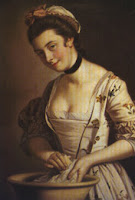 It’s tough to follow on after the heart-wrenching demise of Frisky the Goldfish (and now his successor, gone to both a watery and icy grave). So I thought I’d write today about servants, who I find far more fascinating than the folks upstairs in the drawing room in the labor-intensive regency household. Of course the best thing about servants, for a writer, is that they knew the household secrets and family dynamics better than anyone. I find it interesting, though, that so many regency-era writers get them all wrong, relying on vague ideas of what servants are like (and copying others’ mistakes).
It’s tough to follow on after the heart-wrenching demise of Frisky the Goldfish (and now his successor, gone to both a watery and icy grave). So I thought I’d write today about servants, who I find far more fascinating than the folks upstairs in the drawing room in the labor-intensive regency household. Of course the best thing about servants, for a writer, is that they knew the household secrets and family dynamics better than anyone. I find it interesting, though, that so many regency-era writers get them all wrong, relying on vague ideas of what servants are like (and copying others’ mistakes).
For instance, a female servant would never answer the front door, unless the household was quite poor and she was theonly servant. Neither would she wear a black dress and white cap–that was a uniform that came in much later in the century. Footmen, dressed in livery, were the servants in an aristocrat household who dealed with visitors and guests–status symbols for the family, since there was a tax on male servants. It was the fashion to hire men who were similar in appearance and height, rather like a team of horses (leading to some very interesting possibilities if you have a mind like mine). Female servants hauled coals, emptied chamberpots, and did other dirty work, while their male (and better paid) colleagues minced around in daft uniforms and wigs opening doors and presenting billets-doux on salvers.
For an interesting breakdown on servants and their duties, visit this page (and if you poke around on the site you can also find out how to become a gentleman’s gentleman), http://www.butlerschool.com/interesting_facts.htm.
For a feel of servants’ living and working quarters, take a virtual tour of the “downstairs” at The Regency Town House–it’s described as a time capsule, as it’s the basement of a house in Hove (near Brighton) that has been virtually untouched for almost two centuries. Restoration of the main house, at 13 Brunswick Square is also underway and the servants’ quarters are a couple of doors down at number 10.
 Another interesting servant-oriented stop on your next visit to England is Erddig, an historic house in North Wales, where the former owners (before it was taken over by the National Trust), bless them, didn’t throw away a thing for three centuries, including correspondence with their servants when the masters were away. This unusual family also had portraits painted of their servants and wrote poems in appreciation of them.
Another interesting servant-oriented stop on your next visit to England is Erddig, an historic house in North Wales, where the former owners (before it was taken over by the National Trust), bless them, didn’t throw away a thing for three centuries, including correspondence with their servants when the masters were away. This unusual family also had portraits painted of their servants and wrote poems in appreciation of them.
 A book written for the National Trust about Erddig by Merlin Waterson, The Servants’ Hall, is out of print but you can find secondhand copies online. The Erddig family tradition of staff portraits continued well into the 20th century; in this 1912 photo, each staff member whimsically holdsa tool of their trade (the cook, front row left, is holding a dead pigeon. No wonder they look embarrassed).
A book written for the National Trust about Erddig by Merlin Waterson, The Servants’ Hall, is out of print but you can find secondhand copies online. The Erddig family tradition of staff portraits continued well into the 20th century; in this 1912 photo, each staff member whimsically holdsa tool of their trade (the cook, front row left, is holding a dead pigeon. No wonder they look embarrassed).
The artist William Hogarth painted his servants’ portraits, too. Notice the age range, from a young boy to a middle aged man.

So what was it really like, to be in service? The servants themselves existed in a social heirarchy at least as complicated as that of the people Upstairs.You worked very long, hard hours for not much money, but it was a way, if you scrimped and saved, to make the upward trek into the middle-class. You might end up running an inn or a shop with your sweetheart of many years, if you’d saved up most of your wages and tips (a valuable addition to the low wages most servants earned). A manservant in the 1820s eloquently described his life: The life of a gentleman’s servant is something that of a bird shut up in a cage. The bird is well housed and well fed but is deprived of liberty, and liberty is the dearest and sweetest object of all Englishmen. Therefore I would rather be like a sparrow or a lark, have less housing and feeding and rather more liberty. A servant is shut up like a bird in a cage, deprived of the benefit of the air to the very great injury of the constitution.
Any good servant scenes in anything you’ve read recently? Have you ever wanted to write about servants?
Janet








 Another interesting servant-oriented stop on your next visit to England is
Another interesting servant-oriented stop on your next visit to England is 





